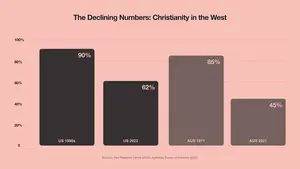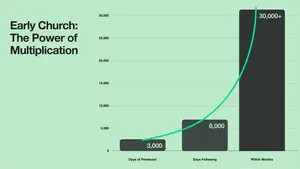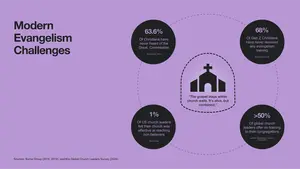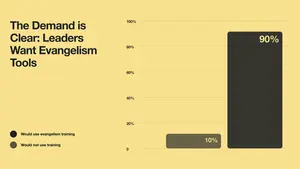This talk explores the urgent need for the Church to return to its disciple-making roots. Tracing the biblical and historical blueprint of Spirit-empowered evangelism, the talk calls for a renewed focus on equipping everyday believers to confidently share Jesus. Highlighting sobering statistics and modern-day challenges, it presents the yesHEis App as a practical solution to reignite the Church’s missional DNA and spark a movement of multiplication once again.
Multiplication starts here: empowering believers to share Jesus

Seizing opportunity at a critical point for the global Church.
A brief look at the Church around the world reveals both a reason for hope and a cause for concern. In regions like Asia and Africa, the Church is experiencing remarkable growth, however, in the west a different story is unfolding.
In the United States, the percentage of adults identifying as Christians has dropped from 90 percent in the 1990s to just 62 percent. In Australia, Christianity declined by more than 40 percent between 1971 and 2021. In Britain, 38 percent of individuals that were raised as Christians now identify as religiously unaffiliated. These aren’t just demographic shifts – they’re a wake-up call. Behind these numbers lies a deeper question:

Are we still following God's call to make disciples?
From the very beginning, God’s desire has been to dwell with his people. Yet since the fall, sin created a barrier between a holy God and a broken humanity. At the cross, Jesus tore down that barrier, making a way for the Holy Spirit to be poured out on all who believe.
Pentecost was more than the birth of the Church – it was a bold declaration: the gospel is for everyone.
What followed was nothing short of miraculous. Ordinary people, empowered by the Spirit, carried the message of Jesus into homes, streets, and nations. They didn’t wait for a stage or a strategy – they simply shared Christ wherever they went. And the result? A movement marked by unstoppable multiplication.
The power of multiplication in the early church.
- 3,000 saved on the day of Pentecost.
- 5,000 more saved in the days following.
- Within months, tens of thousands were added to their number.
What Jesus declared in Acts 1:8 turned out to be more than just a compelling vision – it was a roadmap for the Church’s global expansion. The pattern was clear then, and it's still true now.

"When the gospel is placed in the hands of everyday, spirit-empowered believers, multiplication happens."
Frankie du Toit
Jesus unpacks this idea of multiplication even further in Mark 4. In the Parable of the Sower (Mark 4:23), Jesus likened the gospel to seeds scattered on different soils. The good soil – representing those who hear and accept God’s word – produced a harvest of 30, 60, or 100 times what was planted. So, if that is the blueprint for the spread of the gospel, what happened?
Why did the multiplication slow down?
As the Church grew, so did its structures. In some contexts, faith sharing gradually became associated more with church leaders than with everyday believers. Over time, some expressions of the Church placed greater emphasis on gathering than on going – focusing more on attendance than participation in the wider mission. For centuries, scripture was inaccessible to the masses and discipleship became institutional rather than incarnational.
Yet, history reminds us that every time the gospel is returned to the hands of the people, it multiplies.
During the Reformation, a major turning point came when the bible was translated into common languages and the printing press made it widely accessible. This technological and theological shift broke down barriers, allowing ordinary people to engage with scripture directly. It sparked a spiritual revolution that reformed the Church and activated countless individuals to live and share their faith.
Similarly, movements like the Moravians in the 18th century, the early Methodists under John Wesley, and the house church movement in China, have demonstrated the explosive potential of grassroots, Spirit-led evangelism. These movements thrived not because of structure or strategy, but because they empowered ordinary believers to take ownership of the gospel and boldly share it within their communities and beyond.

The issue today.
Modern research paints a sobering picture.
- 63.6 percent of Christians in the United States have never heard of the Great Commission (Barna, 2018)⁴.
- 68 percent of Gen Z Christians have never received any training in evangelism (Barna, 2019)⁵.
- Only 1 percent of United States church leaders felt their church is effective at reaching out to non-believers (Barna)⁵.
- A 2024 yesHEis survey of more than 100 global church leaders revealed that although most see evangelism as urgent, more than half offer no training to their congregations⁶.
Combine these statistics with today’s consumer-driven church culture and the result is confronting: the gospel stays within church walls. It’s alive but contained.
The solution – a return to the Church's missional DNA.
This isn’t about abandoning church services or pastoral leadership. It’s about returning to our missional identity. Remember, Jesus didn’t call us to maintain – he called us to multiply.
That means:
- Empowering believers to see themselves as everyday missionaries.
- Training them to share Jesus naturally in their context.
- Giving them tools, language, and confidence to speak up in everyday conversations.

This is why we created the yesHEis app.
More than just training, the app provides a digital ecosystem where everyday believers can grow in confidence, access practical evangelism tools, and track their journey. Whether your congregation needs simple conversation starters or ongoing evangelism coaching, the yesHEis App meets people where they are. It also provides visibility into global gospel engagement, helping churches participate in a growing, Spirit-led movement happening in real time across the world. The app is an evangelism tool designed to equip believers at scale.
yesHEis AppIn the same 2024 yesHEis survey, 90 percent of church leaders said they would use evangelism training if it were available and accessible.
Now it is.

Imagine if every believer in your church led one person to Jesus this year.
What if we equipped a generation to attend services and carry the gospel into every corner of culture? The Church doesn’t need to rediscover multiplication. We just need to return to it.
Time to lead the way.
The gospel still multiplies. The question is – are we teaching our people to sow? Let’s lead the way – together.

References
- Pew Research Center, Modeling the Future of Religion in America (Pew Research Center, 2022) https://www.pewresearch.org/religion/2022/09/13/modeling-the-future-of-religion-in-america/ [accessed 21 March 2025].
- Australian Bureau of Statistics, Census of Population and Housing: Reflecting Australia – Stories from the Census, 2021 (Australian Bureau of Statistics, 2022) https://www.abs.gov.au/articles/religious-affiliation-australia [accessed 28 March 2025].
- Pew Research Center, Most of Britain’s Non-Believers Were Raised as Christians (The Times, 2025) https://www.thetimes.co.uk/article/most-of-britains-non-believers-were-raised-as-christians-9th0n9hfb [accessed 21 March 2025].
- Barna Group, 51% of Churchgoers Don’t Know of the Great Commission (Barna Group, 2018) https://www.barna.com/research/half-churchgoers-not-heard-great-commission/ [accessed 21 March 2025].
- Barna Group, Reviving Evangelism: Current Realities That Demand a New Vision for Sharing Faith (Barna Group, 2019) https://www.barna.com/research/reviving-evangelism/ [accessed 21 March 2025].
- yesHEis Global Church Leaders Survey, Internal Research Conducted Across 13 Countries by CV Global and yesHEis (yesHEis, 2024).
